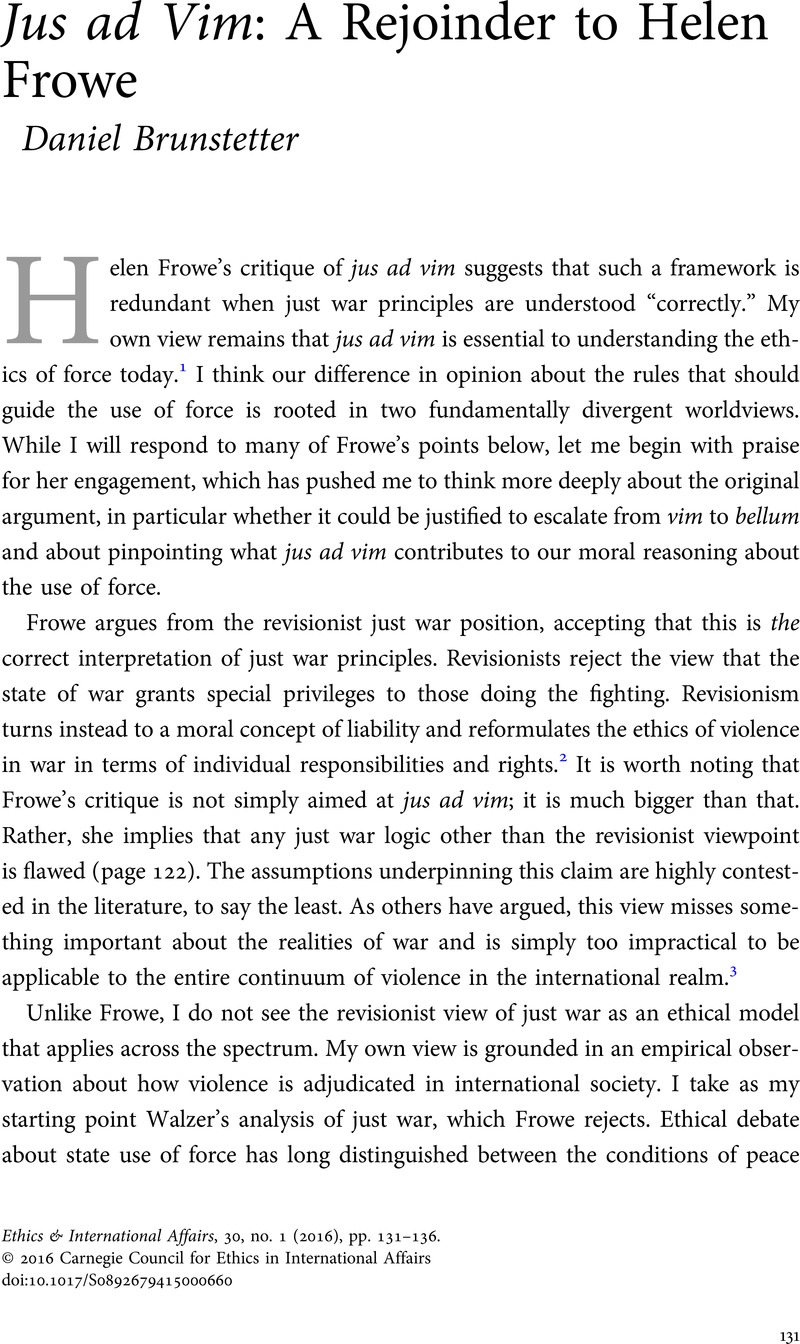Published online by Cambridge University Press: 10 March 2016

1 The views expressed here are my own and not necessarily those of my co-author of the original piece (Megan Braun), who has since pursued a career in law. Some of these ideas were discussed at the Fifth Annual ELAC Workshop on War at Oxford University. I especially thank Heather Roff Perkins, Janina Dill, James Pattison, and Henry Shue for their constructive comments.
2 See the now classic text, Jeff McMahan, Killing in War (New York: Oxford University Press, 2009).
3 Henry Shue, “Do We Need a ‘Morality of War’?” in David Rodin and Henry Shue, eds., Just and Unjust Warriors: The Moral and Legal Status of Soldiers (New York: Oxford University Press, 2008), pp. 87–111; Chris Brown, “Just War and Political Judgment,” in Anthony F. Lang, Cian O'Driscoll, and John Williams, eds., Just War: Authority, Tradition, and Practice (Washington, D.C.: Georgetown University Press, 2013), pp. 25–48; for an alternative view, see Bradley J. Strawser, “Revisionist Just War Theory and the Real World: A Cautiously Optimistic Proposal,” in Fritz Allhoff, Nicholas G. Evans, and Adam Henschke, eds., Routledge Handbook of Ethics and War: Just War Theory in the Twenty-First Century (Abingdon: Routledge, 2013), pp. 76–89.
4 Michael Walzer, Just and Unjust Wars: A Moral Argument with Historical Illustrations (New York: Basic Books, 2006), pp. 51–52.
5 Brunstetter, Daniel and Jiménez-Bacardi, Arturo, “Clashing over Drones: The Legal and Normative Gap between the United States and the Human Rights Community,” International Journal of Human Rights 19, no. 2 (2015), pp. 176–98CrossRefGoogle Scholar.
6 Ian Clarke, Waging War: A New Philosophical Introduction (New York: Oxford University Press, 2015), pp. 129–30.
7 Brunstetter, Daniel and Braun, Megan, “From Jus ad Bellum to Jus ad Vim: Recalibrating Our Understanding of the Moral Use of Force,” Ethics & International Affairs 27, no. 1 (2013), pp. 87–106 CrossRefGoogle Scholar.
8 My thanks to Chris Brown for insight on this point.
9 Brunstetter, Daniel and Braun, Megan, “Rethinking the Criterion for Assessing CIA-Targeted Killings: Drones, Proportionality and Jus Ad Vim ,” Journal of Military Ethics 12, no. 4 (2013), pp. 304–24Google Scholar; p. 319.
10 Brunstetter and Jiménez-Bacardi, “Clashing over Drones.”
11 My subsequent research develops a standard of last resort ad vim for preventive drone strikes that combines elements of traditionalist just war thinking (the permissive right of a state to kill members of a terrorist group as one can kill enemy soldiers under the laws of war) and law enforcement (the right to due process and restrictive collateral damage policy inherent in the law enforcement paradigm). See John Emery and Daniel Brunstetter, “Restricting the Preventive Use of Force: Drones, the Struggle against Non-State Actors, and Jus ad Vim,” in Kerstin Fisk and Jennifer Ramos, eds., Preventive Force: Drones, Targeted Killing, and the Transformation of Contemporary Warfare (New York: NYU Press, forthcoming 2016).
12 Brunstetter and Braun, “Rethinking the Criterion for Assessing CIA-Targeted Killings.”